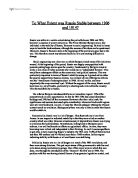The reforms Stolypin introduced did have an immediate impact. 15% of the peasantry took on new opportunities. In fact by 1914 10% had consolidated their holdings and 25% had left the communes However after their initial rush, the significance and success decreased quite considerably. Moreover black earth regions were still very backward. As well, it made the Marxist unhappy. Making the Peasant content meant no revolution. Subsequently there was only a certain extent that Russia could be stable to.
Economically, Russia was in a lot of danger. Thus they took out a loan from France. In one respect in indicated instability in that they now relied on another country which was risky. However simultaneously it depicted how Russia was trying to overcome the backwardness. Nevertheless; linking back to Stolypins social reforms, it as well had knock on affects on agricultural affairs. As now, they were becoming more reliant and independent in their farming. As well it encouraged them to get jobs; in turn improving Russia’s industry. By 1914 only 17.8% of factories had less than 100 workers and 41.4% had more than a 1000 workers. In this respect indicating stability with Russia or at least Russia was stabilising.
Politically, Russia was in a lot of danger as a result of the 1905 revolutions, and there were strong divisions. This put major stress of the government to stabilise and calm down strong revolutionary groups. One of the major ways in which this was done, was through the introduction of the ‘Dumas’s’ the first was in 1906. The problem with this was having elected Dumas of any genuine legislative control, and was mainly controlled by the Tsar. It was dissolved after two months indicating it didn’t have any major success. Then by the second of the Dumas in 1907, there was a lot of opposition particularly towards Stolypins’ land programme. Disagreement lay within the Duma, as well as between the government and the Duma. However, it did have some affects regarding the aim of the regime. The number of Kadets seats was halved. However the SD’s and SR’s benefited quite substantially gaining 188 deputies.
However, by the third Duma June 1907-1912, the Tsar wanted to rid of the regime in hopes to make Russia a democratic nation, relying on the vote of upper classes. The Duma was dominated by right winged parties. However, it made a huge step towards modernising and industrialising Russia in that it allowed Stolypin to go forward with his land reforms without opposition from deputies. This theoretically would help towards stabilising Russia. Although it didn’t go according to plan. In fact it backfired on the Tsar and the government. In fact between 1911-1914 there was a sudden burst of terrorism and public disorder. In 1911 the number of strikes was a mere 24, however by 1914 in rose to 2401. Important to highlight is that Stolypin was assassinated in 1911 in Kiev by a revolutionary agent. This lengthened the drift in right winged affairs. It also demonstrated the opposition to such a key leader, indicating instability in Russia. At the same time, it rid of one of most important men in stabilising Russia, throwing Russia Backward again.
Some events depicting the unrest and public disorder in Russia were the ‘Belis Affair’ in 1913; a Semitic attack and ‘Luna Goldfields Massacre’ in 1912. The Goldfields along the river Lena in April was under horrific violence and disturbance; workers petitioning for better employment and conditions. 270 were killed and 200 injured. This was because revolutionary parties tried to have control, indicating that even though the Dumas’s split the opposition, they weren’t overly effective. Again portraying that Russia was quite unstable.
Overall, Russia was stable to a certain extent. Stolypin achieved his aims of creating ‘capitalist peasants.’ This in turn improved Russia’s agriculture and Industry. However there were still continuous uprising portraying the fact that peasants still weren’t happy depicting instability. At the same time it indicated that even though The Duma’s were put in place to split opposition. It didn’t do so effectively otherwise there wouldn’t have been riots. Financially, Russia was relying on France which mean that it wasn’t independently stable, however enabled them the chance to improve and break out of the vicious circle of backwardness.







